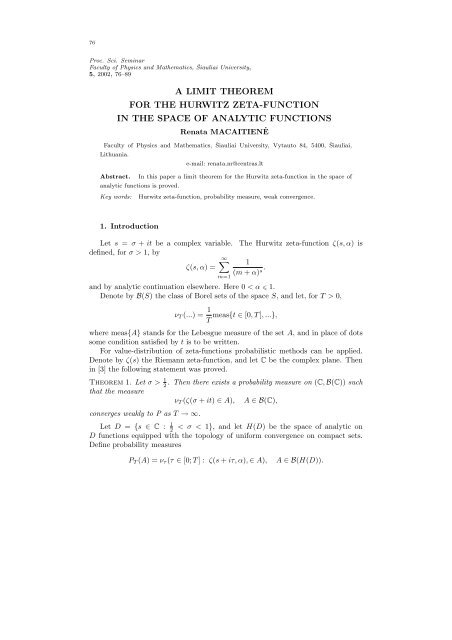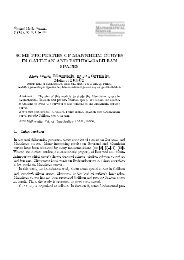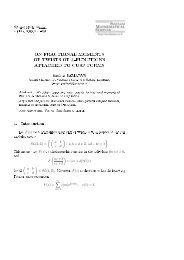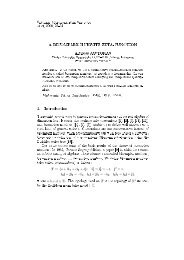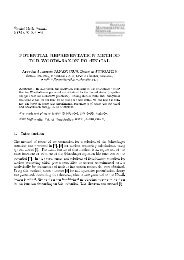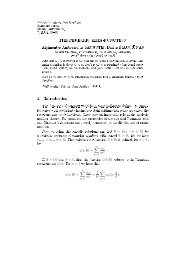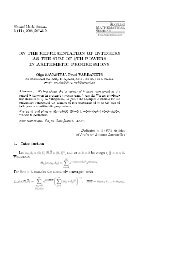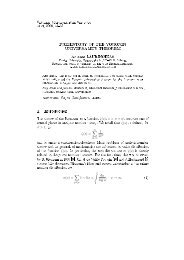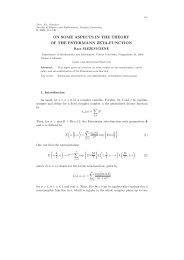a limit theorem for the hurwitz zeta-function in the space of analytic ...
a limit theorem for the hurwitz zeta-function in the space of analytic ...
a limit theorem for the hurwitz zeta-function in the space of analytic ...
Create successful ePaper yourself
Turn your PDF publications into a flip-book with our unique Google optimized e-Paper software.
76<br />
Proc. Sci. Sem<strong>in</strong>ar<br />
Faculty <strong>of</strong> Physics and Ma<strong>the</strong>matics, Šiauliai University,<br />
5, 2002, 76–89<br />
A LIMIT THEOREM<br />
FOR THE HURWITZ ZETA-FUNCTION<br />
IN THE SPACE OF ANALYTIC FUNCTIONS<br />
Renata MACAITIENĖ<br />
Faculty <strong>of</strong> Physics and Ma<strong>the</strong>matics, Šiauliai University, Vytauto 84, 5400, Šiauliai,<br />
Lithuania.<br />
e-mail: renata.m@centras.lt<br />
Abstract. In this paper a <strong>limit</strong> <strong><strong>the</strong>orem</strong> <strong>for</strong> <strong>the</strong> Hurwitz <strong>zeta</strong>-<strong>function</strong> <strong>in</strong> <strong>the</strong> <strong>space</strong> <strong>of</strong><br />
<strong>analytic</strong> <strong>function</strong>s is proved.<br />
Key words: Hurwitz <strong>zeta</strong>-<strong>function</strong>, probability measure, weak convergence.<br />
1. Introduction<br />
Let s = σ + it be a complex variable. The Hurwitz <strong>zeta</strong>-<strong>function</strong> ζ(s, α) is<br />
def<strong>in</strong>ed, <strong>for</strong> σ > 1, by<br />
∞∑ 1<br />
ζ(s, α) =<br />
(m + α) s .<br />
m=1<br />
and by <strong>analytic</strong> cont<strong>in</strong>uation elsewhere. Here 0 < α 1.<br />
Denote by B(S) <strong>the</strong> class <strong>of</strong> Borel sets <strong>of</strong> <strong>the</strong> <strong>space</strong> S, and let, <strong>for</strong> T > 0,<br />
ν T (...) = 1 meas{t ∈ [0, T ], ...},<br />
T<br />
where meas{A} stands <strong>for</strong> <strong>the</strong> Lebesgue measure <strong>of</strong> <strong>the</strong> set A, and <strong>in</strong> place <strong>of</strong> dots<br />
some condition satisfied by t is to be written.<br />
For value-distribution <strong>of</strong> <strong>zeta</strong>-<strong>function</strong>s probabilistic methods can be applied.<br />
Denote by ζ(s) <strong>the</strong> Riemann <strong>zeta</strong>-<strong>function</strong>, and let C be <strong>the</strong> complex plane. Then<br />
<strong>in</strong> [3] <strong>the</strong> follow<strong>in</strong>g statement was proved.<br />
Theorem 1. Let σ > 1 2<br />
. Then <strong>the</strong>re exists a probability measure on (C, B(C)) such<br />
that <strong>the</strong> measure<br />
ν T (ζ(σ + it) ∈ A), A ∈ B(C),<br />
converges weakly to P as T → ∞.<br />
1<br />
Let D = {s ∈ C :<br />
2<br />
< σ < 1}, and let H(D) be <strong>the</strong> <strong>space</strong> <strong>of</strong> <strong>analytic</strong> on<br />
D <strong>function</strong>s equipped with <strong>the</strong> topology <strong>of</strong> uni<strong>for</strong>m convergence on compact sets.<br />
Def<strong>in</strong>e probability measures<br />
P T (A) = ν τ (τ ∈ [0; T ] : ζ(s + iτ, α), ∈ A),<br />
A ∈ B(H(D)).
R. Macaitienė 77<br />
Denote by γ <strong>the</strong> unit circle on C, i. e. γ = {s ∈ C : |s| = 1}, and let<br />
Ω = ∏ m<br />
γ m ,<br />
where γ m = γ <strong>for</strong> each m = 0, 1, . . .. With <strong>the</strong> product topology and po<strong>in</strong>twise multiplication<br />
Ω is a compact Abelian topological group. Then <strong>the</strong>re exists <strong>the</strong> probability<br />
Haar measure m H on (Ω, B(Ω)). This yields a probability <strong>space</strong> (Ω, B(Ω), m H ).<br />
Denote by ω(m) <strong>the</strong> projection <strong>of</strong> ω ∈ Ω to <strong>the</strong> coord<strong>in</strong>ate <strong>space</strong> γ m .<br />
Let ζ(s, ω, α) be <strong>the</strong> H(D)-valued random element on (Ω, B(Ω), m H ) given by<br />
<strong>the</strong> <strong>for</strong>mula<br />
∞∑ ω(m)<br />
ζ(s, ω, α) =<br />
(m + α) s .<br />
m=1<br />
Denote by P ζ <strong>the</strong> distribution <strong>of</strong> <strong>the</strong> random element ζ(s, ω, α), i. e.<br />
P ζ (A) = m H (ω ∈ Ω : ζ(s, ω, α) ∈ A),<br />
A ∈ B(H(D)).<br />
The aim <strong>of</strong> this note is to prove <strong>the</strong> follow<strong>in</strong>g statement. Suppose α is a transcendental<br />
number.<br />
Theorem 2. The probability measure P T converges weakly to P ζ as T → ∞.<br />
2. Auxiliary results<br />
Let<br />
p n (s, α) =<br />
n∑<br />
m=1<br />
1<br />
(m + α) s<br />
be an arbitrary Dirichlet polynomial, D denote some open subset <strong>of</strong> C, and let α is<br />
a transcendental number. We def<strong>in</strong>e <strong>the</strong> probability measure<br />
P T,pn (A) = ν τ T (p n (s + iτ, α) ∈ A),<br />
A ∈ B(H(D)).<br />
Lemma 1. There exists a probability measure P pn on (H(D), B(H(D))) such that<br />
P T,pn converges weakly to P pn as T → ∞.<br />
Pro<strong>of</strong>. Let<br />
Ω m =<br />
n∏<br />
γ m , γ m = γ.<br />
m=0<br />
Let us def<strong>in</strong>e <strong>the</strong> <strong>function</strong> h : Ω n → H(D) by <strong>the</strong> <strong>for</strong>mula<br />
h(x 0 , . . . , x n ) =<br />
n∑<br />
m=0<br />
1<br />
(m + α) s 1<br />
x m<br />
, (x 0 , . . . , x n ) ∈ Ω n .
78 A <strong>limit</strong> <strong><strong>the</strong>orem</strong> <strong>for</strong> <strong>the</strong> Hurwitz <strong>zeta</strong>-<strong>function</strong>...<br />
The <strong>function</strong> h is cont<strong>in</strong>uous on Ω n , and<br />
p n (s + iτ, α) = h(α iτ , (1 + α) iτ , . . . , (n + α) iτ ). (1)<br />
Now we def<strong>in</strong>e <strong>the</strong> probability measure<br />
Q T (A) = νT τ ((α iτ , (1 + α) iτ , . . . , (n + α) iτ ) ∈ A)<br />
on (Ω n , B(Ω n )). The Fourier trans<strong>for</strong>m g T (k 0 , . . . , k n ), k j ∈ Z, j = 1, . . . , n, <strong>of</strong> Q T<br />
is given by <strong>the</strong> <strong>for</strong>mula<br />
∫<br />
g T (k 0 , . . . , k n ) =<br />
Ω<br />
x k 0<br />
0 , . . . , xkn n dQ T = 1 T<br />
∫ T<br />
∫ T<br />
0<br />
n∏<br />
(j + α) ikmτ dτ<br />
j=0<br />
= 1 exp ( n∑<br />
iτ k m log(m + α) ) dτ<br />
T<br />
0<br />
m=0<br />
⎧<br />
1 if (k 0 , . . . , k n ) = (0, . . . , 0),<br />
⎪⎨<br />
( n∑<br />
)<br />
exp iT k m log(m+α)<br />
=<br />
m=0<br />
n∑<br />
if (k 0 , . . . , k n ) ≠ (0, . . . , 0).<br />
⎪⎩ iT k m log(m+α)<br />
m=0<br />
(2)<br />
S<strong>in</strong>ce α is transcendental, log(m + α), m = 0, 1, . . . , n, are l<strong>in</strong>early <strong>in</strong>dependent<br />
over <strong>the</strong> field <strong>of</strong> rational numbers, whence we f<strong>in</strong>d that<br />
g T (k 0 , . . . , k n ) =<br />
{<br />
1 if (k0 , . . . , k n ) = (0, . . . , 0),<br />
0 if (k 0 , . . . , k n ) ≠ (0, . . . , 0)<br />
as T → ∞. There<strong>for</strong>e, <strong>the</strong> measure Q T converges weakly to <strong>the</strong> Haar measure m nH<br />
on (Ω, B(Ω)) as T → ∞. Tak<strong>in</strong>g <strong>in</strong>to account <strong>the</strong> cont<strong>in</strong>uity <strong>of</strong> <strong>the</strong> <strong>function</strong> h and<br />
<strong>the</strong> <strong>for</strong>mula (1), and apply<strong>in</strong>g Theorem 5.1 from [1], we obta<strong>in</strong> that <strong>the</strong> probability<br />
measure P T,pn converges weakly to <strong>the</strong> measure m nH h −1 as T → ∞. The <strong><strong>the</strong>orem</strong><br />
is proved.<br />
Let g(m), m ∈ N, be an arithmetic <strong>function</strong>, |g(m)| = 1,<br />
p n (s, g, α) =<br />
n∑<br />
m=1<br />
g(m)<br />
(m + α) s ,<br />
and<br />
˜P T,pn (A) = ν τ T<br />
(<br />
pn (s + iτ, g, α) ∈ A ) , A ∈ B(H(D)).<br />
Lemma 2. The probability measures P T,pn and ˜P T,pn both converge weakly to <strong>the</strong><br />
same measure as T → ∞.
R. Macaitienė 79<br />
Pro<strong>of</strong>. Let <strong>the</strong> <strong>function</strong> h 1 : Ω n → Ω n be def<strong>in</strong>ed by <strong>the</strong> <strong>for</strong>mula<br />
h 1 (x 0 , . . . , x n ) = (x 0 e −iθ 0<br />
, . . . , x n e −iθ n<br />
),<br />
where θ m = arg g(m), m = 0, . . . , n. By Lemma 1 <strong>the</strong> probability measures P n,pn<br />
and ˜P n,pn converges weakly to <strong>the</strong> measures m nH h −1 and m nH˜h−1 , respectively,<br />
where <strong>the</strong> <strong>function</strong> ˜h is similar to h. It is easy to see that<br />
˜h(x0 , . . . , x n ) =<br />
Consequently,<br />
n∑<br />
m=0<br />
g(m)<br />
(m + α) s x m<br />
=<br />
n∑<br />
m=0<br />
e iθm<br />
(m + α)x m<br />
= h(h 1 (x 0 , . . . , x n )).<br />
m nH˜h−1 = m nH (h(h 1 )) −1 = m nH (h −1<br />
1 )h−1 . (3)<br />
S<strong>in</strong>ce <strong>the</strong> Haar measure m nH is <strong>in</strong>variant with respect to translation by po<strong>in</strong>ts <strong>in</strong> Ω,<br />
we have that m nH h −1<br />
1 = m nH . It follows from this and from (3) that m nH˜h−1 =<br />
m nH h −1<br />
1 . This proves <strong>the</strong> lemma.<br />
3. Aplication <strong>of</strong> <strong>the</strong> ergodic <strong>the</strong>ory<br />
Denote by D a compact Abelian topological group. Let m D be <strong>the</strong> Haar measure<br />
on (D, B(D)). A one-parameter family {ϕ τ : τ ∈ R} <strong>of</strong> trans<strong>for</strong>mations on D is<br />
called a one-parameter group <strong>of</strong> trans<strong>for</strong>mations if <strong>for</strong> τ, τ 1 , τ 2 ∈ R, g ∈ D, we have<br />
ϕ τ1 +τ 2<br />
(g) = ϕ τ1 (ϕ τ2 (g)) and ϕ −τ (g) = ϕ −1<br />
τ (g).<br />
Let a τ = {(m + α) −iτ : 0 < α < 1}, τ ∈ R, m ∈ N 0 , N 0 = N ∪ {0}. Then<br />
{a τ : τ ∈ R} is a one-parameter group. We def<strong>in</strong>e <strong>the</strong> one-parameter family<br />
{ϕ τ : τ ∈ R} <strong>of</strong> trans<strong>for</strong>mations on Ω tak<strong>in</strong>g ϕ τ (ω) = a τ ω, ω ∈ Ω. Then we have<br />
that {ϕ τ : τ ∈ R} is a one-parameter group <strong>of</strong> measurable trans<strong>for</strong>mations on Ω.<br />
Lemma 3. The one-parameter group {ϕ τ : τ ∈ R} is ergodic.<br />
Pro<strong>of</strong> is similar to that from [3].<br />
Denote by EX <strong>the</strong> mean <strong>of</strong> <strong>the</strong> random element X.<br />
Lemma 4. Let a process X(τ, ω) be ergodic, E|X(τ, ω)| < ∞ and let sample paths<br />
be <strong>in</strong>tegrable almost surely <strong>in</strong> <strong>the</strong> Riemann sense over every f<strong>in</strong>ite <strong>in</strong>terval. Then<br />
almost surely.<br />
Pro<strong>of</strong> can be found <strong>in</strong> [2].<br />
∫<br />
1<br />
T<br />
lim X(τ, ω)dτ = EX(0, ω)<br />
T →∞ T<br />
0
80 A <strong>limit</strong> <strong><strong>the</strong>orem</strong> <strong>for</strong> <strong>the</strong> Hurwitz <strong>zeta</strong>-<strong>function</strong>...<br />
Lemma 5. Let T → ∞ and 1 2<br />
< σ < 1. Then<br />
∫ T<br />
0<br />
|ζ(σ + it, ω, α)| 2 dt = BT<br />
<strong>for</strong> almost all ω ∈ Ω.<br />
Pro<strong>of</strong>. Let<br />
Then<br />
Denote<br />
ζ m (σ, ω, α) =<br />
ζ(σ, ω, α) =<br />
ω(m)<br />
(m + α) σ , m ∈ N 0.<br />
∞∑<br />
ζ m (σ, ω, α).<br />
m=0<br />
ˆζ(σ, ω, α) = |ζ(σ, ω, α)| 2 .<br />
S<strong>in</strong>ce<br />
E|ζ m (σ, ω, α)| 2 =<br />
1<br />
(m + α) 2σ ,<br />
and <strong>the</strong> random variables ζ m (σ, ω, α) are pairwise ortogonal, we f<strong>in</strong>d that<br />
It is obvious that<br />
E|ˆζ(σ, ω, α)| =<br />
∞∑<br />
E|ζ m (σ, ω, α)| 2 =<br />
m=0<br />
∞∑<br />
m=1<br />
1<br />
< ∞. (4)<br />
(m + α)<br />
2σ<br />
ˆζ(σ, ϕ τ (ω), α) = |ζ(σ, a τ ω, α)| 2 = |ζ(σ + iτ, ω, α)| 2 . (5)<br />
S<strong>in</strong>ce <strong>the</strong> Haar measure is <strong>in</strong>variant, <strong>the</strong> equality m H (ϕ τ (A)) = m H (A) is valid<br />
<strong>for</strong> each A ∈ B(Ω) and every τ ∈ R. There<strong>for</strong>e |ζ(σ + iτ, ω, α)| 2 is a strongly<br />
stationary process. It is also an ergodic process. In fact, let A be an <strong>in</strong>variant set<br />
<strong>of</strong> |ζ(σ + iτ, ω, α)| 2 , i. e.<br />
Q(A∆A u ) = 0. (6)<br />
We have that<br />
A ′<br />
A ′ u<br />
def<br />
= {ω ∈ Ω : |ζ(σ + iτ, ω, α)| 2 ∈ A} = {ω ∈ Ω : |ζ(σ, a τ ω, α)| 2 ∈ A},<br />
def<br />
= {ω ∈ Ω : |ζ(σ + iτ, ω, α)| 2 ∈ A u } = {ω ∈ Ω : |ζ(σ + iτ + iu, ω, α)| 2 ∈ A}<br />
= {ω ∈ Ω : |ζ(σ + iτ, a u ω, α)| 2 ∈ A}.<br />
There<strong>for</strong>e A ′ u = ϕ u (A ′ ) and (A∆A u ) ′ = A ′ ∆A ′ u. From this and from (6) we deduce<br />
that m H (A ′ ∆A ′ u) = m H ((A∆A u ) ′ ) = Q(A∆A u ), that is A ′ is an <strong>in</strong>variant set with<br />
respect to ϕ τ . But, by Lemma 3, <strong>the</strong> group {ϕ τ : τ ∈ R} is ergodic. There<strong>for</strong>e
R. Macaitienė 81<br />
m(A ′ ) = 0 or m(A ′ ) = 1. Hence it follows that Q(A) = 0 or Q(A) = 1, i. e. <strong>the</strong><br />
process |ζ(σ + iτ, ω, α)| 2 is ergodic.<br />
Observ<strong>in</strong>g that ˆζ(σ, ϕ τ (ω), α) 0 and us<strong>in</strong>g (4), (5) we deduce from Lemma 4<br />
that<br />
∫<br />
1<br />
T<br />
∫<br />
1<br />
T<br />
lim ˆζ(σ, ϕ τ (ω), α)dt = lim |ζ(σ + iτ, ω, α)| 2 dτ = E<br />
T →∞ T<br />
T →∞ T<br />
ˆζ(σ, ω, α)<br />
0<br />
0<br />
<strong>for</strong> almost all ω ∈ Ω. From this by (4) we obta<strong>in</strong> <strong>the</strong> assertion <strong>of</strong> <strong>the</strong> lemma.<br />
4. Approximation by mean <strong>of</strong> <strong>the</strong> <strong>function</strong> ζ(s, α)<br />
Let σ 1 > 1 2<br />
. We def<strong>in</strong>e <strong>the</strong> <strong>function</strong><br />
l n (s, α) = s σ 1<br />
Γ ( s<br />
σ 1<br />
)<br />
(n + α) s , n ∈ N,<br />
<strong>in</strong> <strong>the</strong> strip 1 2 < σ < 1. Moreover, let <strong>for</strong> σ 1 > 1 2<br />
ζ 2,n (s, α) = 1<br />
2πi<br />
∫<br />
σ 1+i∞<br />
σ 1−i∞<br />
ζ(s + z, α)l n (z, α) dz<br />
z .<br />
S<strong>in</strong>ce Γ(σ + it) = Be −c 1|t| , uni<strong>for</strong>mly <strong>in</strong> σ, |σ| c 1 , <strong>the</strong> <strong>in</strong>tegral <strong>for</strong> ζ 2,n (s, α) exists.<br />
Lemma 6. Let a and b be positive numbers. Then <strong>the</strong> <strong>for</strong>mula<br />
is valid.<br />
Pro<strong>of</strong> can be found <strong>in</strong> [4].<br />
1<br />
2πi<br />
∫<br />
b+i∞<br />
b−i∞<br />
Γ(s)a −s ds = e −a<br />
Lemma 7. Let K be a compact subset <strong>of</strong> <strong>the</strong> strip σ > 1 2 . Then<br />
lim<br />
lim<br />
∫ T<br />
n→∞ T →∞<br />
0<br />
sup |ζ(σ + iτ, α) − ζ 2,n (s + iτ, α)|dτ = 0.<br />
s∈K
82 A <strong>limit</strong> <strong><strong>the</strong>orem</strong> <strong>for</strong> <strong>the</strong> Hurwitz <strong>zeta</strong>-<strong>function</strong>...<br />
Pro<strong>of</strong>. By choice <strong>of</strong> σ 1 and σ we have that σ+σ 1 > 1. Consequently, <strong>the</strong> <strong>function</strong><br />
ζ(s + z, α) <strong>for</strong> Rez = σ 1 , is represented by an absolutely convergent Dirichlet series<br />
Let<br />
Consider <strong>the</strong> series<br />
S<strong>in</strong>ce<br />
ζ(s + z, α) =<br />
a n (m, α) = 1<br />
2πi<br />
a n (m, α) = B(m + α) −σ 1<br />
∞∑<br />
m=1<br />
∫ ∞<br />
−∞<br />
∞∑<br />
m=1<br />
1<br />
(m + α) s+z .<br />
σ 1+i∞ ∫<br />
σ 1 −i∞<br />
l n (s, α)ds<br />
s(m + α) s .<br />
a n (m, α)<br />
(m + α) s . (7)<br />
|l n (σ 1 + it, α)|dt = B(m + α) −σ 1<br />
,<br />
<strong>the</strong> series (7) converges absolutely <strong>for</strong> σ > 1 2<br />
. Thus, <strong>in</strong>terchang<strong>in</strong>g sum and <strong>in</strong>tegral<br />
<strong>in</strong> <strong>the</strong> def<strong>in</strong>ition <strong>of</strong> ζ 2,n , we f<strong>in</strong>d<br />
By Lemma 6<br />
ζ 2,n (s, α) =<br />
∞∑<br />
m=1<br />
{<br />
a n (m, α) = exp −<br />
There<strong>for</strong>e <strong>the</strong> equality (8) can be writen as<br />
ζ 2,n (s, α) =<br />
∞∑<br />
m=1<br />
{<br />
1<br />
(m + α) s exp −<br />
a n (m, α)<br />
(m + α) s . (8)<br />
( ) σ1<br />
}<br />
(m + α)<br />
.<br />
(n + α)<br />
( ) σ1<br />
}<br />
(m + α)<br />
,<br />
(n + α)<br />
<strong>the</strong> series be<strong>in</strong>g absolutely convergent <strong>for</strong> σ > 1 2 .<br />
Now we change <strong>the</strong> contour <strong>in</strong> <strong>the</strong> <strong>in</strong>tegral <strong>for</strong> ζ 2,n (s, α). The <strong>in</strong>tegrand has<br />
simple poles at z = 0 and z = 1 − s. Let σ belong to σ ∈ [ 1 2<br />
+ ε, 1 − ε] when s ∈ K.<br />
We put<br />
Then by <strong>the</strong> residue <strong><strong>the</strong>orem</strong><br />
ζ 2,n (s, α) = 1<br />
2πi<br />
∫<br />
σ 2−σ+i∞<br />
σ 2−σ−i∞<br />
σ 2 = 1 2 + ε 2 .<br />
ζ(s + z, α)l n (z, α) dz<br />
z + ζ(s, α) + l n(1 − s, α)<br />
. (9)<br />
1 − s
R. Macaitienė 83<br />
1<br />
Let L be a simple closed contour ly<strong>in</strong>g <strong>in</strong> {s ∈ C :<br />
2<br />
< σ < 1} and enclos<strong>in</strong>g<br />
<strong>the</strong> set K, and let δ denote <strong>the</strong> distance <strong>of</strong> L from <strong>the</strong> set K. Then by <strong>the</strong> Cauchy<br />
<strong>for</strong>mula we have<br />
sup |ζ(s + iτ, α) − ζ 2,n (s + iτ, α)| 1 ∫<br />
|ζ(z + iτ, α) − ζ 2,n (z + iτ, α)||dz|.<br />
s∈K<br />
2πδ<br />
There<strong>for</strong>e we obta<strong>in</strong> that, <strong>for</strong> sufficiently large T ,<br />
∫<br />
1<br />
T<br />
sup |ζ(s + iτ, α) − ζ 2,n (s + iτ, α)|dτ<br />
T s∈K<br />
0<br />
= B T δ<br />
∫<br />
L<br />
= B|L|<br />
T δ<br />
∫<br />
|dz|<br />
2T<br />
0<br />
+ B|L|<br />
T δ<br />
L<br />
|ζ(Rez + iτ, α) − ζ 2,n (s + iτ, α)|dτ + B|L|<br />
T δ<br />
sup<br />
∫2T<br />
σ,s∈L<br />
0<br />
The contour L can be chosen so that <strong>the</strong> <strong>in</strong>equalities<br />
|ζ(s + it, α) − ζ 2,n (s + it, α)|dt.<br />
σ 1 2 + 3ε<br />
4 , δ ε 4<br />
should hold. Then by (9) we have that <strong>for</strong> such σ<br />
ζ(s + it, α) − ζ 2,n (s + it, α) = B<br />
∫ ∞<br />
−∞<br />
|ζ(σ 2 + it + iτ, α)||l n (σ 2 − σ + iτ, α)|dτ<br />
+ B|l n(1 − σ − it, α)|<br />
.<br />
|1 − σ − it|<br />
Hence, <strong>for</strong> <strong>the</strong> same σ, <strong>in</strong> virtue <strong>of</strong> <strong>the</strong> properties <strong>of</strong> l n (s, α) and ζ(s, α), we f<strong>in</strong>d<br />
that<br />
1<br />
T<br />
∫2T<br />
0<br />
= B<br />
|ζ(σ + it, α) − ζ 2,n (σ + it, α)|dt<br />
∫ ∞<br />
−∞<br />
+ B T<br />
∫2T<br />
0<br />
|l n (σ 2 − σ + iτ, α)| 1 T<br />
|l n (1 − σ − it, α)|<br />
dt.<br />
|1 − σ − it|<br />
|τ|+2T<br />
∫<br />
−|τ|<br />
|ζ(σ 2 + it, α)|dtdτ<br />
(11)
84 A <strong>limit</strong> <strong><strong>the</strong>orem</strong> <strong>for</strong> <strong>the</strong> Hurwitz <strong>zeta</strong>-<strong>function</strong>...<br />
It is known that<br />
∫ T<br />
Now it follows from (11) and (12) that<br />
1<br />
T sup<br />
∫2T<br />
σ,s∈L<br />
0<br />
= B sup<br />
0<br />
|ζ(σ 2 + it, α)| 2 dt = BT. (12)<br />
|ζ(σ + it, α) − ζ 2,n (σ + it, α)|dt<br />
∫ ∞<br />
σ,s∈L<br />
−∞<br />
+ B T sup<br />
∫2T<br />
σ,s∈L<br />
0<br />
= B sup<br />
σ∈[− 1 2 + 3ε<br />
|l n (σ 2 − σ + iτ, α)| ( 2 + 2|τ| )<br />
dτ<br />
T<br />
|l n (1 − σ − it, α)|<br />
dt<br />
|1 − σ − it|<br />
∫<br />
2 ,− ε 4 ] ∞<br />
−∞<br />
|l n (σ + it, α)|(1 + |τ|)dτ + o(1)<br />
as T → ∞. From <strong>the</strong> def<strong>in</strong>ition <strong>of</strong> <strong>the</strong> <strong>function</strong> l n (s, α) we deduce that<br />
∫<br />
lim sup |l n (σ + it, α)|(1 + |τ|)dτ = 0.<br />
∞<br />
n→∞<br />
σ∈[− 1 2 + 3ε<br />
2 ,− ε 4 ] −∞<br />
This equality toge<strong>the</strong>r with (13) ir (10) gives <strong>the</strong> assertion <strong>of</strong> <strong>the</strong> <strong><strong>the</strong>orem</strong>.<br />
(13)<br />
5. Limit <strong><strong>the</strong>orem</strong> <strong>in</strong> <strong>the</strong> <strong>space</strong> <strong>of</strong> <strong>analytic</strong> <strong>function</strong>s <strong>for</strong> <strong>the</strong> absolutely<br />
convergent series<br />
Let <strong>for</strong> ω ∈ Ω,<br />
ζ 2,n (s, ω, α) =<br />
∞∑<br />
m=1<br />
{<br />
ω(m)<br />
(m + α) s exp −<br />
( ) σ1<br />
}<br />
(m + α)<br />
.<br />
(n + α)<br />
S<strong>in</strong>ce |ω(m)| = 1, <strong>the</strong> series <strong>for</strong> ζ 2,n (s, ω, α) converges absolutely on <strong>the</strong> half-plane<br />
σ > 1 2<br />
. We def<strong>in</strong>e two probability measures on (H(D), B(H(D)))<br />
P 1 T,n(A) = ν τ T (ζ 2,n (s + iτ, α) ∈ A),<br />
Q 1 T,n(A) = ν τ T (ζ 2,n (s + iτ, ω, α) ∈ A).<br />
Lemma 8. There exists a probability measure P 1 n on (H(D), B(H(D))) such that<br />
both measures P 1 T,n and Q1 T,n converge weakly to P 1 n as T → ∞.<br />
Pro<strong>of</strong> is similar to that <strong>for</strong> <strong>the</strong> case <strong>of</strong> <strong>the</strong> Riemann <strong>zeta</strong>-<strong>function</strong> and uses<br />
Lemma 2.
R. Macaitienė 85<br />
6. Pro<strong>of</strong> <strong>of</strong> Theorem 2<br />
Let Ω 1 be a subset <strong>of</strong> Ω such that <strong>for</strong> ω 1 ∈ Ω 1 <strong>the</strong> series<br />
∞∑<br />
m=1<br />
ω 1 (m)<br />
(m + α) s<br />
converges uni<strong>for</strong>mly on compact subsets <strong>of</strong> D and, let <strong>for</strong> σ > 1 2<br />
, <strong>the</strong> estimate<br />
be valid. By Lemma 5 we have that m H (Ω 1 ) = 1.<br />
Lemma 9. Let K be a compact subsed <strong>of</strong> D. Then<br />
<strong>for</strong> ω 1 ∈ Ω 1 .<br />
lim<br />
lim<br />
n→∞ T →∞<br />
1<br />
T<br />
∫ T<br />
0<br />
∫ T<br />
0<br />
|ζ(σ + it, ω 1 , α)| 2 dt = BT (14)<br />
sup |ζ(s + iτ, ω 1 , α) − ζ n (s + iτ, ω 1 , α)|dτ = 0,<br />
s∈K<br />
Pro<strong>of</strong>. The lemma is proved similarly to Lemma 7, s<strong>in</strong>ce by (14) and <strong>the</strong> Cauchy<br />
<strong>in</strong>equality <strong>the</strong> estimate<br />
∫ T<br />
follows.<br />
Let<br />
0<br />
|ζ(σ + it, ω 1 , α)|dt = BT<br />
Q T (A) = ν τ T (ζ(s + iτ, ω 1 , α) ∈ A),<br />
A ∈ B(H(D)).<br />
Lemma 10. There exists a probability measure P 1 on (H(D), B(H(D))) such that<br />
<strong>the</strong> measures P T and Q T both converge weakly to P 1 as T → ∞.<br />
Pro<strong>of</strong>. By Lemma 8 both <strong>the</strong> measures PT,n 1 and Q1 T,n converge weakly to <strong>the</strong><br />
same measure Pn 1 as T → ∞. First we will prove that <strong>the</strong> family <strong>of</strong> probability<br />
measures {Pn} 1 is tight.<br />
Let θ be a random variable, uni<strong>for</strong>mly distributed <strong>in</strong> <strong>the</strong> <strong>in</strong>terval [0, 1] and<br />
Then by Lemma 8 we have that<br />
X T,n (s, α) = ζ 2,n (s + iT θ, α).<br />
X T,n<br />
D<br />
−→ Xn , T → ∞, (15)
86 A <strong>limit</strong> <strong><strong>the</strong>orem</strong> <strong>for</strong> <strong>the</strong> Hurwitz <strong>zeta</strong>-<strong>function</strong>...<br />
where X n is an H(D)-valued random element hav<strong>in</strong>g <strong>the</strong> distribution P 1 n.<br />
Let {K l } be a sequence <strong>of</strong> compact subsets <strong>of</strong> D such that<br />
∞⋃<br />
K l = D,<br />
l=1<br />
K l ⊂ K l+1 , and if K is a compact <strong>of</strong> D, <strong>the</strong>n K ⊆ K l <strong>for</strong> some l. Def<strong>in</strong>e<br />
ρ(f, g) =<br />
∞∑<br />
l=1<br />
2 −l ρ l (f, g)<br />
, f, g ∈ H(D),<br />
1 + ρ l (f, g)<br />
where ρ l (f, g) = sup<br />
s∈K l<br />
|f(s) − g(s)|. Then ρ is a metric on H(D) which <strong>in</strong>duces its<br />
topology.<br />
S<strong>in</strong>ce <strong>the</strong> series <strong>for</strong> ζ 2,n (s, α) is absolutely convergent <strong>in</strong> D, we have<br />
sup<br />
lim<br />
n1 T →∞<br />
1<br />
T<br />
∫ T<br />
0<br />
sup |ζ 2,n (s + iτ, α)|dτ R l < ∞. (16)<br />
s∈K l<br />
Let ε > 0 and M l = R l2 l<br />
ε<br />
. Then by <strong>the</strong> Chebyshev <strong>in</strong>equality<br />
P ( )<br />
sup |X T,n (s, α)| > M 1<br />
l <br />
s∈K l<br />
T M l<br />
∫T<br />
0<br />
sup |ζ 2,n (s + iτ, α)|dτ,<br />
s∈K l<br />
and, consequently,<br />
Thus we f<strong>in</strong>d that<br />
and, <strong>for</strong> all n 1,<br />
lim P( )<br />
sup |X T,n (s, α)| > M ε l <br />
T →∞ s∈K l<br />
2 l .<br />
P ( )<br />
sup |X n (s, α)| > M ε l <br />
s∈K l<br />
2 l ,<br />
P ( X n (s, α) ∈ H ε<br />
)<br />
1 − ε<br />
or, s<strong>in</strong>ce P 1 n is <strong>the</strong> distribution <strong>of</strong> X n ,<br />
P 1 n(H ε ) 1 − ε,<br />
where H ε = {h ∈ H(D) : sup |h(s)| M l , l 1}. The set H ε is compact.<br />
s∈K l<br />
There<strong>for</strong>e <strong>the</strong> family <strong>of</strong> <strong>the</strong> measures {Pn} 1 is tight, and by <strong>the</strong> Prokhorov <strong><strong>the</strong>orem</strong><br />
it is relatively compact.
R. Macaitienė 87<br />
Aply<strong>in</strong>g <strong>the</strong> Chebyshev <strong>in</strong>equality once more and Lemma 7, we deduce that <strong>for</strong><br />
every ε > 0<br />
lim lim<br />
(<br />
ρ(ζ(s + iτ, α), ζ2,n (s + iτ, α)) ε )<br />
Let<br />
n→∞ T →∞ ντ T<br />
∫ T<br />
lim<br />
lim<br />
n→∞ T →∞<br />
1<br />
εT<br />
0<br />
ρ(ζ(s + iτ, α), ζ 2,n (s + iτ, α))dτ = 0.<br />
Y T (s, α) = ζ(s + iT θ, α).<br />
Then <strong>the</strong> relation (17) can be written <strong>in</strong> <strong>the</strong> <strong>for</strong>m<br />
lim<br />
n→∞<br />
(17)<br />
lim P(ρ(X T,n(s, α), Y T (s, α)) ε) = 0. (18)<br />
T →∞<br />
Let {P 1 n ′} bet a subsequence <strong>of</strong> {P 1 n} which converges weakly to some measure<br />
P 1 . S<strong>in</strong>ce <strong>the</strong> <strong>space</strong> H(D) is separable, by (15) we have that<br />
X n ′<br />
D<br />
−→ P 1 , n ′ → ∞.<br />
From this and <strong>the</strong> relations (15) and (18), we deduce that<br />
Y T<br />
D<br />
−→ P 1 , T → ∞. (19)<br />
This relation is equivalent to <strong>the</strong> weak convergence <strong>of</strong> P T to P 1 . From (19) <strong>in</strong> view<br />
<strong>of</strong> <strong>the</strong> relative compactness <strong>of</strong> <strong>the</strong> family {Pn} 1 and <strong>of</strong> <strong>the</strong> assertion (The relation<br />
P n ⇒ P is true if and only if every subsequence P n ′ conta<strong>in</strong>s ano<strong>the</strong>r subsequence<br />
P n ′′ such that P n ′′ ⇒ P ) we get<br />
X n<br />
D<br />
−→ P 1 , n → ∞. (20)<br />
and<br />
Repeat<strong>in</strong>g <strong>the</strong> analogous reason<strong>in</strong>g <strong>for</strong> <strong>the</strong> random elements<br />
˜X T,n (s, ω 1 , α) = ζ 2,n (s + iT θ, ω 1 , α)<br />
Ỹ T (s, ω 1 , α) = ζ(s + iT θ, ω 1 , α)<br />
and apply<strong>in</strong>g Lemma 9 and (20), we obta<strong>in</strong> that <strong>the</strong> measure Q T converges weakly<br />
to P 1 as T → ∞. The lemma is proved.<br />
Pro<strong>of</strong> <strong>of</strong> Theorem 2. Lemma 10 asserts that <strong>the</strong> measures P T and Q T converge<br />
weakly to some measure P 1 as T → ∞ simultaneously. It rema<strong>in</strong>s to prove that<br />
P 1 = P ζ .<br />
Let A ∈ B(H(D)) be a cont<strong>in</strong>uity set <strong>of</strong> P 1 . Then by Lemma 10 we have that<br />
lim<br />
T →∞ ντ T (ζ(s + iτ, ω 1 , α) ∈ A) = P 1 (A). (21)
88 A <strong>limit</strong> <strong><strong>the</strong>orem</strong> <strong>for</strong> <strong>the</strong> Hurwitz <strong>zeta</strong>-<strong>function</strong>...<br />
Let us fix <strong>the</strong> set A and def<strong>in</strong>e <strong>the</strong> random variable θ on (Ω, B(Ω), m H ) by <strong>the</strong><br />
<strong>for</strong>mula<br />
{<br />
1 if ζ(s, ω, α) ∈ A,<br />
θ(ω) =<br />
0 if ζ(s, ω, α) /∈ A.<br />
It is easy to verify that<br />
∫<br />
E(θ) =<br />
Ω<br />
θdm H = m H (ω : ζ(s, ω, α) ∈ A) = P ζ < ∞. (22)<br />
Tak<strong>in</strong>g <strong>in</strong>to account Lemma 3 an reason<strong>in</strong>g similarly as <strong>in</strong> <strong>the</strong> pro<strong>of</strong> <strong>of</strong> Lemma 5,<br />
we obta<strong>in</strong> that θ(ϕ τ (ω)) is an ergodic process. There<strong>for</strong>e <strong>in</strong> view <strong>of</strong> Lemma 4<br />
lim<br />
∫ T<br />
T →∞<br />
0<br />
θ(ϕ τ (ω))dτ = E(θ) (23)<br />
<strong>for</strong> almost all ω ∈ Ω. But from <strong>the</strong> def<strong>in</strong>itions <strong>of</strong> <strong>the</strong> random variable θ and <strong>of</strong> <strong>the</strong><br />
one-parameter group {ϕ τ : τ ∈ R} it follows that<br />
∫ T<br />
0<br />
θ(ϕ τ (ω))dτ = ν τ T (ζ(s + iτ, ω, α) ∈ A).<br />
This, (22) and (23) give us<br />
<strong>for</strong> almost all ω. Thus, <strong>in</strong> view <strong>of</strong> (21)<br />
( )<br />
lim<br />
T →∞ ντ T ζ(s + iτ, ω, α) ∈ A = Pζ (A)<br />
P 1 (A) = P ζ (A)<br />
<strong>for</strong> any cont<strong>in</strong>uity set A <strong>of</strong> <strong>the</strong> measure P 1 . S<strong>in</strong>ce <strong>the</strong> cont<strong>in</strong>uity sets constitute <strong>the</strong><br />
determ<strong>in</strong><strong>in</strong>g class, we have that<br />
P 1 (A) = P ζ (A)<br />
<strong>for</strong> all A ∈ B(H(D)).<br />
The <strong><strong>the</strong>orem</strong> is proved.
R. Macaitienė 89<br />
REFERENCES<br />
[1] P. Bill<strong>in</strong>gsley, Convergence <strong>of</strong> Probability Measures, John Wiley, New York (1968).<br />
[2] H. Cramér, M. R. Leadbeeter, Stationary and Related Stochastic Processes, Wiley, New York<br />
(1967).<br />
[3] A. Laur<strong>in</strong>čikas, Limit Theorems <strong>for</strong> <strong>the</strong> Riemann <strong>zeta</strong>-<strong>function</strong>, Kluwer, Dordrecht, Boston,<br />
London (1996).<br />
[4] E. C. Titchmarsh, The Theory <strong>of</strong> Functions, Ox<strong>for</strong>d University Press (1939).<br />
[5] B. V. Shabat, Introduction to Complex analysis, Nauka, Moscow (1969).<br />
Rib<strong>in</strong>ė teorema Hurwitz’o d<strong>zeta</strong> funkcijai analiz<strong>in</strong>iu ‘<br />
funkciju ‘<br />
erdvėje<br />
R. Macaitienė<br />
Straipsnyje i ‘<br />
rodoma rib<strong>in</strong>ė teorema Hurvitz’o d<strong>zeta</strong> funkcijai analiz<strong>in</strong>iu ‘<br />
funkciju ‘<br />
erdvėje.<br />
Rankraštis gautas<br />
2002 07 04


